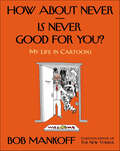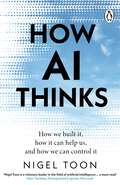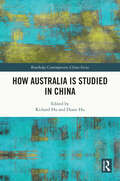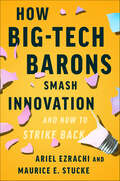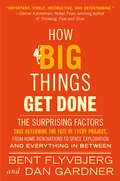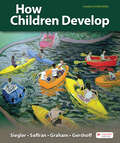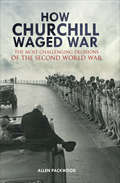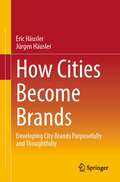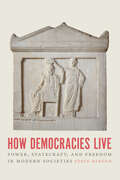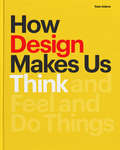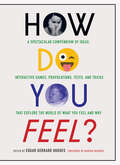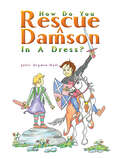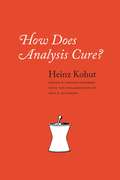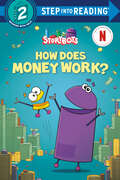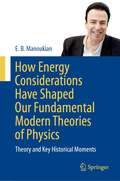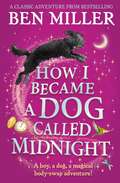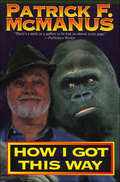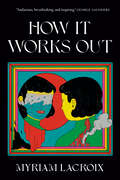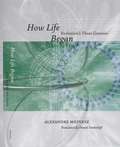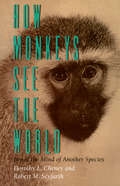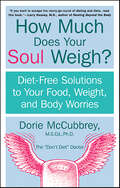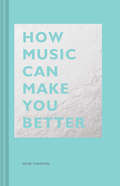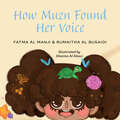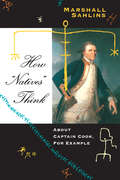- Table View
- List View
How About Never—Is Never Good for You?: My Life in Cartoons
by Bob MankoffMemoir in cartoons by the longtime cartoon editor of The New YorkerPeople tell Bob Mankoff that as the cartoon editor of The New Yorker he has the best job in the world. Never one to beat around the bush, he explains to us, in the opening of this singular, delightfully eccentric book, that because he is also a cartoonist at the magazine he actually has two of the best jobs in the world. With the help of myriad images and his funniest, most beloved cartoons, he traces his love of the craft all the way back to his childhood, when he started doing funny drawings at the age of eight. After meeting his mother, we follow his unlikely stints as a high-school basketball star, draft dodger, and sociology grad student. Though Mankoff abandoned the study of psychology in the seventies to become a cartoonist, he recently realized that the field he abandoned could help him better understand the field he was in, and here he takes up the psychology of cartooning, analyzing why some cartoons make us laugh and others don't. He allows us into the hallowed halls of The New Yorker to show us the soup-to-nuts process of cartoon creation, giving us a detailed look not only at his own work, but that of the other talented cartoonists who keep us laughing week after week. For desert, he reveals the secrets to winning the magazine's caption contest. Throughout How About Never--Is Never Good for You?, we see his commitment to the motto "Anything worth saying is worth saying funny."
How AI Thinks: How we built it, how it can help us, and how we can control it
by Nigel ToonTHE #2 TIMES BESTSELLER'Artificial intelligence is going to have a massive impact on everyone’s lives... an accessible and sensible read that helps demystify AI' Deborah Meaden, entrepreneur and star of Dragon's Den'Nigel Toon is a visionary leader in the field of artificial intelligence... a must-read' Marc Tremblay, Distinguished Engineer, MicrosoftThose who understand how AI thinks are about to win big.We are used to thinking of computers as being a step up from calculators - very good at storing information, and maybe even at playing a logical game like chess. But up to now they haven't been able to think in ways that are intuitive, or respond to questions as a human might. All that has changed, dramatically, in the past few years.Our search engines are becoming answer engines. Artificial intelligence is already revolutionising sectors from education to healthcare to the creative arts. But how does an AI understand sentiment or context? How does it play and win games that have an almost infinite number of moves? And how can we work with AI to produce insights and innovations that are beyond human capacity, from writing code in an instant to unfolding the elaborate 3D puzzles of proteins?We stand at the brink of a historic change that will disrupt society and at the same time create enormous opportunities for those who understand how AI thinks. Nigel Toon shows how we train AI to train itself, so that it can paint images that have never existed before or converse in any language. In doing so he reveals the strange and fascinating ways that humans think, too, as we learn how to live in a world shared by machine intelligences of our own creation.
How Australia is Studied in China (ISSN)
by Richard Hu Diane HuChina has arguably the largest community of Australian studies in the world. However, not much is known about this phenomenon, including its emergence, rationale, interests, influences, and the implications for strategic Australia-China engagement in a region of increasing challenge and uncertainty. This volume unpacks how Australia is taught, learnt, researched, communicated, and promoted in the Asian giant as well as its largest trade partner. In doing so, it penetrates the representation and essence of this phenomenon to seek both the ‘Australianness’ and the ‘Chineseness’ in it.This volume collects contributions from a group of leading and emerging Chinese and Australian scholars—who are members and insiders of this community—to jointly debate on this intellectual entity and its significant influences and implications. Produced at a critical moment of commemorating half a century of China-Australia diplomatic relations and four decades of formalised Australian studies in China, this volume provides an up-to-date, comprehensive, and insightful examination of this Australia-China engagement.It will be of interest to scholars, students, policymakers, and general readers in areas of Australian studies, Chinese studies, Asia-Pacific studies, China-Australia relations, and international relations.
How Big-Tech Barons Smash Innovation—and How to Strike Back
by Ariel Ezrachi Maurice E. StuckeTwo market experts deconstruct the drivers and inhibitors to innovation in the digital economy, explain how large tech companies can stifle disruption, assess the toll of their technologies on our well-being and democracy, and outline policy changes to take power away from big tech and return it to entrepreneurs.Silicon Valley’s genius combined with limited corporate regulation promised a new age of technological innovation in which entrepreneurs would create companies that would in turn fuel unprecedented job growth. Yet disruptive innovation has stagnated even as the five leading tech giants, which account for approximately 25 percent of the S&P 500’s market capitalization, are expanding to unimaginable scale and power. In How Big-Tech Barons Smash Innovation—and How to Strike Back, Ariel Ezrachi and Maurice E. Stucke explain why this is happening and what we can do to reverse it.While many distrust the Big-Tech Barons, the prevailing belief is that innovation is thriving online. It isn’t. Rather than disruptive innovations that create significant value, we are getting technologies that primarily extract value and reduce well-being. Using vivid examples and relying on their work in the field, the authors explain how the leading tech companies design their sprawling ecosystems to extract more profits (while crushing any entrepreneur that poses a threat). As a result, we get less innovation that benefits us and more innovations that surpass the dreams of yesteryears’ autocracies. The Tech Barons’ technologies, which seek to decode our emotions and thoughts to better manipulate our behavior, are undermining political stability and democracy while fueling tribalism and hate.But it’s not hopeless. The authors reveal that sustained innovation scales with cities not companies, and that we, as a society, should profoundly alter our investment strategy and priorities to certain entrepreneurs (“Tech Pirates”) and cities’ infrastructure.
How Big Things Get Done: The Surprising Factors That Determine the Fate of Every Project, from Home Renovations to Space Exploration and Everything In Between
by Bent Flyvbjerg Dan Gardner&“Why do big projects go wrong so often, and are there any lessons you can use when renovating your kitchen? Bent Flyvbjerg is the &‘megaproject&’ expert and Dan Gardner brings the storytelling skills to How Big Things Get Done, with examples ranging from a Jimi Hendrix studio to the Sydney Opera House.&”—Financial Times &“Entertaining . . . There are lessons here for managers of all stripes.&”—The EconomistA BEST BOOK OF THE YEAR: Economist, Financial Times, CEO Magazine, MorningstarFinalist for the Porchlight Business Book Award, the Financial Times and Schroders Business Book of the Year Award, and the Inc. Non-Obvious Book AwardNothing is more inspiring than a big vision that becomes a triumphant, new reality. Think of how the Empire State Building went from a sketch to the jewel of New York&’s skyline in twenty-one months, or how Apple&’s iPod went from a project with a single employee to a product launch in eleven months.These are wonderful stories. But most of the time big visions turn into nightmares. Remember Boston&’s &“Big Dig&”? Almost every sizeable city in the world has such a fiasco in its backyard. In fact, no less than 92% of megaprojects come in over budget or over schedule, or both. The cost of California&’s high-speed rail project soared from $33 billion to $100 billon—and won&’t even go where promised. More modest endeavors, whether launching a small business, organizing a conference, or just finishing a work project on time, also commonly fail. Why?Understanding what distinguishes the triumphs from the failures has been the life&’s work of Oxford professor Bent Flyvbjerg, dubbed &“the world&’s leading megaproject expert.&” In How Big Things Get Done, he identifies the errors in judgment and decision-making that lead projects, both big and small, to fail, and the research-based principles that will make you succeed with yours. For example:• Understand your odds. If you don&’t know them, you won&’t win.• Plan slow, act fast. Getting to the action quick feels right. But it&’s wrong. • Think right to left. Start with your goal, then identify the steps to get there.• Find your Lego. Big is best built from small.• Be a team maker. You won&’t succeed without an &“us.&”• Master the unknown unknowns. Most think they can&’t, so they fail. Flyvbjerg shows how you can.• Know that your biggest risk is you.Full of vivid examples ranging from the building of the Sydney Opera House, to the making of the latest Pixar blockbusters, to a home renovation in Brooklyn gone awry, How Big Things Get Done reveals how to get any ambitious project done—on time and on budget.
How Children Develop, Canadian Edition
by Robert Siegler Jenny Saffran Susan Graham Nancy Eisenberg Elizabeth GershoffHow Children Develop, Seventh Edition, is the trusted introduction to child development in Canada from a team of leading teachers and researchers.
How Churchill Waged War: The Most Challenging Decisions of the Second World War
by Allen PackwoodAn analytical investigation into Prime Minister Winston Churchill&’s decision-making process during every stage of World War II. When Winston Churchill accepted the position of Prime Minister in May 1940, he insisted in also becoming Minister of Defence. This, though, meant that he alone would be responsible for the success or failure of Britain&’s war effort. It also meant that he would be faced with many monumental challenges and utterly crucial decisions upon which the fate of Britain and the free world rested. With the limited resources available to the UK, Churchill had to pinpoint where his country&’s priorities lay. He had to respond to the collapse of France, decide if Britain should adopt a defensive or offensive strategy, choose if Egypt and the war in North Africa should take precedence over Singapore and the UK&’s empire in the East, determine how much support to give the Soviet Union, and how much power to give the United States in controlling the direction of the war. In this insightful investigation into Churchill&’s conduct during the Second World War, Allen Packwood, BA, MPhil (Cantab), FRHistS, the Director of the Churchill Archives Centre, enables the reader to share the agonies and uncertainties faced by Churchill at each crucial stage of the war. How Churchill responded to each challenge is analyzed in great detail and the conclusions Packwood draws are as uncompromising as those made by Britain&’s wartime leader as he negotiated his country through its darkest days.
How Cities Become Brands: Developing City Brands Purposefully and Thoughtfully
by Eric Häusler Jürgen HäuslerThis book explores how the fragile and lengthy process of developing a city brand can be carefully managed. Necessary background information is explained, numerous experiences are reported, and targeted city branding is inspired in a variety of ways.The dream of every brand maker: to develop a city into a strong city brand - perhaps even a myth. The creation of myths remains a curiosity. Is it targeted, are there relevant recipes for success, and can those responsible be identified? Above all: Can the process be replicated? How do brand makers deal with the complexity of the phenomena of cities and city brands? How do they give the arduous process of creating a city brand a reasonable chance of success? How do brand makers deal with the often biting criticism from outside and the nagging self-doubt?Successful cityscapes arise from the trials and tribulations of complex and sometimes random processes. In the course of global city competition, this evolutionaryprocess is enriched with the achievements of the craft of branding. This is not a guarantee of success. Success depends on numerous prerequisites, which are discussed in detail. Finally, craft rules for good and at the same time sensitive city branding are mentioned.The translation was done with the help of artificial intelligence. A subsequent human revision was done primarily in terms of content.nal criticism and self-doubts?City images emerge from complex and random processes. In global urban competition, this process is enriched with brand making achievements. Success isn't guaranteed, depending on discussed conditions. Lastly, rules for effective city branding are outlined.nal criticism and self-doubts?City images emerge from complex and random processes. In global urban competition, this process is enriched with brand making achievements. Success isn't guaranteed, depending on discussed conditions. Lastly, rules foreffective city branding are outlined.nal criticism and self-doubts?City images emerge from complex and random processes. In global urban competition, this process is enriched with brand making achievements. Success isn't guaranteed, depending on discussed conditions. Lastly, rules for effective city branding are outlined.nal criticism and self-doubts?City images emerge from complex and random processes. In global urban competition, this process is enriched with brand making achievements. Success isn't guaranteed, depending on discussed conditions. Lastly, rules for effective city branding are outlined.nal criticism and self-doubts?City images emerge from complex and random processes. In global urban competition, this process is enriched with brand making achievements. Success isn't guaranteed, depending on discussed conditions. Lastly, rules for effective city branding are outlined.nal criticism and self-doubts?City images emergefrom complex and random processes. In global urban competition, this process is enriched with brand making achievements. Success isn't guaranteed, depending on discussed conditions. Lastly, rules for effective city branding are outlined.nal criticism and self-doubts?City images emerge from complex and random processes. In global urban competition, this process is enriched with brand making achievements. Success isn't guaranteed, depending on discussed conditions. Lastly, rules for effective city branding are outlined.City images emerge from complex and random processes. In global urban competition, this process is enriched with brand making achievements. Success isn't guaranteed, depending on discussed conditions. Lastly, rules for effective city branding are outlined.City images emerge from complex and random processes. In global urban competition, this process is enriched with brand making achievements. Success isn't guaranteed, depending on discussedconditions. Lastly, rules for effective city branding are outlined.City images emerge from
How Democracies Live: Power, Statecraft, and Freedom in Modern Societies
by Stein RingenTimes have not been kind to democracy. This book is in its defense. In the new century, the triumph of democracy at the end of the Cold War turned to retrenchment. The core democracies, in America and Britain, succumbed to polarization and misrule. Dictatorships, such as China, made themselves assertive. New democracies in Central Europe turned to muddled ideologies of “illiberal democracy.” In this book, Stein Ringen offers a meditation on what democracy is, the challenges it faces, and how it can be defended. Ringen argues that democracy must be rooted in a culture that supports the ability of citizens to exchange views and information among themselves and with their rulers. Drawing on the ideas of Machiavelli, Aristotle, Tocqueville, Max Weber, and others, Ringen shows how power is the fuel of government, and statecraft turns power into effective rule. Democracy should prize freedom and minimizing unfairness, especially poverty. Altogether, Ringen offers powerful insight on the meaning of democracy, including a new definition, and how countries can improve upon it and make it function more effectively. Timely and thought-provoking, How Democracies Live is a sober reminder of the majesty of the democratic enterprise.
How Design Makes Us Think: And Feel and Do Things
by Sean AdamsFrom posters to cars, design is everywhere. While we often discuss the aesthetics of design, we don't always dig deeper to unearth the ways design can overtly, and covertly, convince us of a certain way of thinking. How Design Makes Us Think collects hundreds of examples across graphic design, product design, industrial design, and architecture to illustrate how design can inspire, provoke, amuse, anger, or reassure us.Graphic designer Sean Adams walks us through the power of design to attract attention and convey meaning. The book delves into the sociological, psychological, and historical reasons for our responses to design, offering practitioners and clients alike a new appreciation of their responsibility to create design with the best intentions. How Design Makes Us Think is an essential read for designers, advertisers, marketing professionals, and anyone who wants to understand how the design around us makes us think, feel, and do things.
How Do You Feel?: Understand Your Emotions through Charts, Tests, Questionnaires, and Interactive Games
by Edgar Gerrard HughesAn insightful and fun interactive guide to understanding the what, how, and why of your emotions.Almost every moment of our lives is suffused with emotion, yet we rarely think about what these emotions mean, how they're formed, and how to address them. How Do You Feel? gathers decades of recent research on emotions in accessible short essays and engaging activities that let you be your own guide in learning about your emotions. With questionnaires, quizzes, assessments, and more, How Do Your Feel? is great for groups or individuals, and will entertain, inform, surprise, and help you get to know yourself better.
How Do You Rescue a Damson in a Dress?
by Julie Dryden-HallEmbark on a whimsical tale of curiosity, adventure, sibling camaraderie, and a sprinkle of delightful misinterpretation in How Do You Rescue a Damson In A Dress? With eyes sparkling with wonder and a heart buoyed by courage, our young prince gallantly trails behind his elder brother, embarking on what he believes to be a noble quest to rescue a ‘Damson in a Dress.’ Unbeknownst to him, his brother is on a mission to save a Damsel in Distress. Armed with a valiant sword, a stash of sweets, and a flask of milk to quench his thirst, the young prince steps into a world brimming with enchanting adventures yet perilous encounters. His path intertwines with a formidable grizzly bear, a cunning and greedy wolf, a menacing crocodile, and the mythical Nessy Monster. Despite the lurking dangers, his youthful bravado never wavers. As the veil of misinterpretation humorously unfolds, will our young hero find the ‘Damson’ he seeks? Or will he discover a greater understanding of his brother’s true quest?
How Does Analysis Cure?
by Heinz Kohut Paul E. StepanskyThe Austro-American psychoanalyst Heinz Kohut was one of the foremost leaders in his field and developed the school of self-psychology, which sets aside the Freudian explanations for behavior and looks instead at self/object relationships and empathy in order to shed light on human behavior. In How Does Analysis Cure? Kohut presents the theoretical framework for self-psychology, and carefully lays out how the self develops over the course of time. Kohut also specifically defines healthy and unhealthy cases of Oedipal complexes and narcissism, while investigating the nature of analysis itself as treatment for pathologies. This in-depth examination of “the talking cure” explores the lesser studied phenomena of psychoanalysis, including when it is beneficial for analyses to be left unfinished, and the changing definition of “normal.” An important work for working psychoanalysts, this book is important not only for psychologists, but also for anyone interested in the complex inner workings of the human psyche.
How Does Money Work? (Step into Reading)
by Scott EmmonsThe robots from Netflix's StoryBots Answer Time star in an all-new Step 2 Step into Reading leveled reader!Bing wants to know what money is and why we use it. His questions lead him from a bank to a tour of a successful lemonade stand. What he learns will fascinate children ages 4 to 6 who love Netflix's educational show.Step 2 Readers use basic vocabulary and short sentences to tell simple stories. For children who recognize familiar words and can sound out new words with help.
How Does Santa Go Down the Chimney?
by Mac BarnettWhen Santa arrives at a child’s house on Christmas Eve, does he go down the chimney feetfirst or headfirst? What if he gets stuck? What if there’s no chimney? Maybe he slides under the door, as thin as a piece of paper? Or is it possible he pours himself through the faucet? What happens once he’s inside? Whether it’s shape-shifting or impromptu laundry use, Mac Barnett’s iconic talent for earnest deadpan humor and Jon Klassen’s irresistibly funny art honor the timeless question with answers both ridiculous and plausible, mounting in hilarity as the night continues. Channeling a child’s fanciful explanations (and begging for further speculation), this latest collaboration by a New York Times best-selling team will find a secure spot among family holiday traditions.
How Energy Considerations Have Shaped Our Fundamental Modern Theories of Physics: Theory and Key Historical Moments
by E. B. ManoukianAt long last, with sufficient technical details, emphasizing key historical moments, a book that develops all of fundamental modern theoretical physics from energy considerations in a compact form. Starting with a few electron-volts of atoms in the quantum world at low energies extending up to quantum gravity and beyond to the birth of the Universe, readers will experience the entire spectrum of fundamental modern theoretical physics, with one theory leading to another in an integrated unified manner. Energy considerations lead to the development of special and general relativity, quantum field theory, renormalization theory, modern quantum electrodynamics, electro-weak theory, the standard model of particle physics, grand unified theories, string theory, the current standard model of inflationary big bang theory, and even to the birth of the Higgs field, and in developments of quantum gravity. Unfortunately, due to strong specialization within theirfields, students and many practicing physicists are exposed only to parts of the beautiful story of modern fundamental physics. Here the entire story is told! This is a must-read book for graduate students, advanced undergraduate students, instructors and professionals who are interested in all aspects of fundamental modern theoretical physics and key historical moments in its development.
How I Became a Dog Called Midnight: A magical adventure from the bestselling author of The Day I Fell Into a Fairytale
by Ben Miller'Wonderful, funny, magical' Chris Evans&‘A sheer delight for all kids both big AND small&’ Ruth Jones on The Night I Met Father Christmas 'Bubbles with warmth and mischievous humour . . . irresistible' Alexander Armstrong on The Night I Met Father ChristmasA boy, a dog, and a magical body-swap adventure! Enter a world of wonder in this classic adventure from top-ten bestselling children's author, Ben Miller. George has always wondered what it's like to be a dog. One night, a magical mix-up with an enchanted fountain means he swaps places with Midnight, a huge and loveable hound! Becoming a dog is an amazing adventure, until George uncovers a plan that could threaten Midnight's home. Can the two friends save the day before the clock strikes twelve and leaves them stuck in each other's bodies forever? A magical race-against-time for a boy and his dog best friend – discover the funny and heartwarming classic storytelling from bestselling author and beloved actor, Ben Miller.*The Night We Got Stuck in a Story – a brand-new, magical adventure from bestselling author, Ben Miller – is out now!*Praise for Ben Miller:'A magical adventure' Sunday Express on The Day I Fell Into a Fairytale'Great for reading aloud' The Week Junior on The Day I Fell Into a Fairytale'A fire-side gem of a story' Abi Elphinstone on The Night I Met Father Christmas'Fabulous' Sunday Express on The Boy Who Made the World Disappear'Enchanting, funny and intriguing in equal measure' Philip Ardagh on The Night I Met Father Christmas'Each of [Ben&’s] five books is joyous and thoughtful' Red Magazine
How I Got This Way
by Patrick F. McManusPatrick McManus, the bestselling author of such hilarious books as A Fine and Pleasant Misery and Never Sniff a Gift Fish, now offers readers solid thoughts on the qualities that define leadership, beginning with the need to be tall, and much more, in this outrageous collection of short pieces that reveals his tortuous trip along the writer's path.
How It Works Out
by Myriam Lacroix&“Audacious, breathtaking, and inspiring.&” —GEORGE SAUNDERS&“Madcap, delirious, exhilaratingly good.&” —KELLY LINK&“A delightfully bizarre and unabashedly queer revelation.&” —TEGAN and SARA QUIN &“A beautifully brilliant, hilariously sad stunner of a debut that never forgets about the heart.&” —NANA KWAME ADJEI-BRENYAHWhat if you had the chance to rewrite the course of your relationship, again and again, in the hopes that it would work out?When Myriam and Allison fall in love at a show in a run-down punk house, their relationship begins to unfold through a series of hypotheticals. What if they became mothers by finding a baby in an alley? What if the only cure for Myriam&’s depression was Allison&’s flesh? What if they were B-list celebrities, famous for writing a book about building healthy lesbian relationships? How much darker—or sexier—would their dynamic be if one were a power-hungry CEO, and the other her lowly employee? From the fantasies of early romance to the slow encroaching of violence that unravels the fantasy, each reality builds to complete a brilliant, painfully funny portrait of love&’s many promises and perils.Equal parts sexy and profane, unsentimental, and gut-wrenching, How It Works Out is a genre-bending, arresting, uncanny exploration of queerness, love, and our drive for connection, in any and all possible worlds.
How Life Began: Evolution's Three Geneses
by Alexandre MeineszThe origin of life is a hotly debated topic. The Christian Bible states that God created the heavens and the Earth, all in about seven days roughly six thousand years ago. This episode in Genesis departs markedly from scientific theories developed over the last two centuries which hold that life appeared on Earth about 3.5 billion years ago in the form of bacteria, followed by unicellular organisms half a millennia later. It is this version of genesis that Alexandre Meinesz explores in this engaging tale of life's origins and evolution. How Life Began elucidates three origins, or geneses, of life—bacteria, nucleated cells, and multicellular organisms—and shows how evolution has sculpted life to its current biodiversity through four main events—mutation, recombination, natural selection, and geologic cataclysm. As an ecologist who specializes in algae, the first organisms to colonize Earth, Meinesz brings a refreshingly novel voice to the history of biodiversity and emphasizes here the role of unions in organizing life. For example, the ingestion of some bacteria by other bacteria led to mitochondria that characterize animal and plant cells, and the chloroplasts of plant cells. As Meinesz charmingly recounts, life’s grandeur is a result of an evolutionary tendency toward sociality and solidarity. He suggests that it is our cohesion and collaboration that allows us to solve the environmental problems arising in the decades and centuries to come. Rooted in the science of evolution but enlivened with many illustrations from other disciplines and the arts, How Life Began intertwines the rise of bacteria and multicellular life with Vermeer’s portrait of Antoni van Leeuwenhoek, the story of Genesis and Noah, Meinesz’s son’s early experiences with Legos, and his own encounters with other scientists. All of this brings a very human and humanistic tone to Meinesz’s charismatic narrative of the three origins of life.
How Monkeys See the World: Inside the Mind of Another Species
by Robert M. Seyfarth Dorothy L. CheneyCheney and Seyfarth enter the minds of vervet monkeys and other primates to explore the nature of primate intelligence and the evolution of cognition. "This reviewer had to be restrained from stopping people in the street to urge them to read it: They would learn something of the way science is done, something about how monkeys see their world, and something about themselves, the mental models they inhabit."—Roger Lewin, Washington Post Book World "A fascinating intellectual odyssey and a superb summary of where science stands."—Geoffrey Cowley, Newsweek "A once-in-the-history-of-science enterprise."—Duane M. Rumbaugh, Quarterly Review of Biology
How Much Does Your Soul Weigh?: Diet-Free Solutions to Your Food, Weight, and Body Worries
by Dorie McCubbreyYou hold in your hands a life-changing weight control revelation -- a holistic approach to help you overcome all eating and weight problems from anorexia to obesity. This innovative book will shed light on your unsuccessful attempts at dieting and help you begin to heal from the inside out, once and for all!How many "miracle diets" have you tried? How many minutes and hours have you spent worrying about the numbers on the bathroom scale? How many times have you lost weight only to gain it back along with renewed disappointment and frustration? You've worried about how much your body weighs, but have you asked: How Much Does Your Soul Weigh?Dr. Doric McCubbrey, a weight-issues specialist whose practice boasts a 95 percent success rate, reveals that the weight of your soul may be preventing you from effecting the changes you want to see in your appearance and self-esteem. By starting Dr. Dorie's plan for "Intuitive Self-Care," you can begin to unburden your soul of all the "weighty attitudes" of the diet mentality -- rigid rules, negative self-talk, and unrealistic goals -- that lead to very real feelings of disappointment and hopelessness.With empathy and insight, Dr. Doric explores and explains the importance of a soulful attitude toward your eating, exercise, and weight. You'll discover:the "games" dieters play -- and why none of them worksthe four archetypal weight problems and how to overcome them for goodthe secrets of naturally thin people -- and how you can incorporate them into your lifea 30-day plan of therapeutic "recipes" designed especially to nourish your soulPacked with stories from Dr. Dorie's own 15-year struggle with overeating, anorexia, and bulimia, and the experiences of her clients, How Much Does Your Soul Weigh? shows you how to generate the happiness, health, balance, and confidence that will put your weight worries to rest for good!
How Music Can Make You Better: (motivational Book, Neuroscience Book) (The HOW Series)
by Indre Viskontas PhDHow can certain songs carry us through a tough workout, comfort us after a breakup, or unite 50,000 diverse fans? In this fascinating field guide, neuroscientist and opera singer Indre Viskontas investigates what music is and how it can change us for the better—from deep in our neurons to across our entire society. Whether hip-hop fans, classically trained pianists, or vinyl collectors, readers will think about their favorite songs in a whole new way by the end of this book. This is a vibrant and smart gift for any audiophile.
How Muzn Found Her Voice
by Fatma Al-ManjiThe story’s main character, Muzn, is a young girl living near the Strait of Hormuz and has a fear of public speaking because of her stutter. All Muzn wants is to hide and not speak, but her grandmother and butterfly sidekick Sama never allow her to give up and in fact take her on a journey that changes her perspective forever.
How "Natives" Think: About Captain Cook, For Example
by Marshall SahlinsWhen Western scholars write about non-Western societies, do they inevitably perpetuate the myths of European imperialism? Can they ever articulate the meanings and logics of non-Western peoples? Who has the right to speak for whom? Questions such as these are among the most hotly debated in contemporary intellectual life. In How "Natives" Think, Marshall Sahlins addresses these issues head on, while building a powerful case for the ability of anthropologists working in the Western tradition to understand other cultures. In recent years, these questions have arisen in debates over the death and deification of Captain James Cook on Hawai'i Island in 1779. Did the Hawaiians truly receive Cook as a manifestation of their own god Lono? Or were they too pragmatic, too worldly-wise to accept the foreigner as a god? Moreover, can a "non-native" scholar give voice to a "native" point of view? In his 1992 book The Apotheosis of Captain Cook, Gananath Obeyesekere used this very issue to attack Sahlins's decades of scholarship on Hawaii. Accusing Sahlins of elementary mistakes of fact and logic, even of intentional distortion, Obeyesekere portrayed Sahlins as accepting a naive, enthnocentric idea of superiority of the white man over "natives"—Hawaiian and otherwise. Claiming that his own Sri Lankan heritage gave him privileged access to the Polynesian native perspective, Obeyesekere contended that Hawaiians were actually pragmatists too rational and sensible to mistake Cook for a god. Curiously then, as Sahlins shows, Obeyesekere turns eighteenth-century Hawaiians into twentieth-century modern Europeans, living up to the highest Western standards of "practical rationality." By contrast, Western scholars are turned into classic custom-bound "natives", endlessly repeating their ancestral traditions of the White man's superiority by insisting Cook was taken for a god. But this inverted ethnocentrism can only be supported, as Sahlins demonstrates, through wholesale fabrications of Hawaiian ethnography and history—not to mention Obeyesekere's sustained misrepresentations of Sahlins's own work. And in the end, although he claims to be speaking on behalf of the "natives," Obeyesekere, by substituting a home-made "rationality" for Hawaiian culture, systematically eliminates the voices of Hawaiian people from their own history.How "Natives" Think goes far beyond specialized debates about the alleged superiority of Western traditions. The culmination of Sahlins's ethnohistorical research on Hawaii, it is a reaffirmation for understanding difference.
